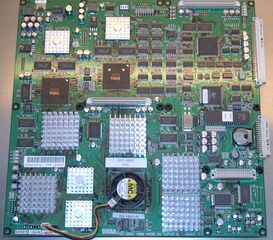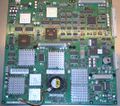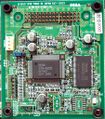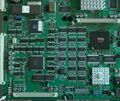Sega Hikaru
From Sega Retro

| |||||
| Sega Hikaru | |||||
|---|---|---|---|---|---|
| Manufacturer: Sega | |||||
|
The Sega Hikaru is a successor of the NAOMI (and Sega Model 3) hardware that was developed in 1998 and debuted in 1999. The Hikaru was used for a handful of deluxe dedicated-cabinet games, beginning with 1999's Brave Fire Fighters, in which the flame and water effects were largely a showpiece for the hardware.
It was significantly more powerful and expensive than the NAOMI. The Hikaru featured a custom Sega GPU with advanced graphical capabilities, additional CPU and sound processors, various custom processors, increased memory, and faster bandwidth. It was the first game platform capable of effective hardware Phong shading and was capable of the most complex lighting and particle effects of its time.
It was the most powerful game system of its time, but very expensive. Since it was comparatively expensive to produce, Sega soon abandoned the Hikaru in favor of continued NAOMI development. It was succeeded by the NAOMI 2, which was not as powerful, but more affordable.
Contents
Development
According to Sega in 1999: [1]
| “ | Brave Firefighters utilizes a slightly modified Naomi Hardware system called Hikaru. Hikaru incorporates a custom Sega graphics chip and possesses larger memory capacity then standard Naomi systems. "These modifications were necessary because in Brave Firefighters, our engineers were faced with the daunting challenge of creating 3d images of flames and sprayed water," stated Sega's Vice President of Sales and Marketing, Barbara Joyiens. "If you stop and think about it, both have an almost infinite number of shapes, sizes, colors, levels of opaqueness, shadings and shadows. And, when you combine the two by simulating the spraying of water on a flame, you create an entirely different set of challenges for our game designers and engineers to overcome; challenges that would be extremely difficult, if not impossible to overcome utilizing existing 3D computers. Hikaru has the horsepower to handle these demanding graphic challenges with clarity, depth and precision." | „ |
In addition, the Hikaru also uses two Hitachi SH-4 CPU processors, two Yamaha AICA sound engine processors, a Motorola 68000 network CPU, and a dual GPU setup. The Hikaru hardware was largely complete in 1998, before it was released to the public in 1999. [2]
Specifications
- Board composition: Main Board, ROM Board, AICA Sound Board, I/O Board, Filter Board, Network Board [2]
- Main CPU: 2× Hitachi SH‑4 @ 200 MHz
- Features: 2× 128‑bit SIMD @ 200 MHz, 2× floating‑point unit, graphic functions
- Bus width: 128‑bit (2× 64‑bit)
- SH‑4 performance: 720 MIPS, 2.8 GFLOPS, more than 20 million polygons/sec geometry & lighting calculations
- Note: With Sega Custom 3D GPU geometry processors, the SH‑4's 128‑bit SIMD matrix unit can be dedicated to game physics, artificial intelligence, collision detection, overall game code, and/or further enhancing graphics.
- Memory control processors:
- Network Board processors:
- Operating systems:
- Sega native operating system
- Custom Windows CE, with DirectX 6.0, Direct3D and OpenGL support
- Extensions: communication, 4‑channel surround audio, PCI, MIDI, RS‑232C
- Connection: JAMMA Video compliant
Sound
- Sound engine: 2× Yamaha AICA Super Intelligent Sound Processor @ 67 MHz
- Internal CPU: 2× 32‑bit ARM7 RISC CPU @ 45 MHz
- CPU performance: 34 MIPS (2× 17 MIPS)
- PCM/ADPCM: 16‑bit depth, 48 kHz sampling rate (DVD quality), 128 channels
- Bus width: 32‑bit (2× 16‑bit)
- Other features: DSP, sound synthesizer
Graphics
- Main Graphics Engine GPU: Sega Custom 3D GPU @ 250 MHz [8][9][10][3]
- Processor cores: 17 processors (including 2 GPU Command Processors, 2 GPU DMA controllers, 2 Image Generator rasterizers/renderers) [2][11]
- 10× Sega custom processors: 315‑6083A, 315‑6085, 315‑6086, 315‑6087, 315‑6146, 315‑6232, 2× 315‑6084, 2× 315‑6197
- 2× Lattice GAL16V8 GAL @ 250 MHz (128‑bit, DMA control, graphics processing) [12]
- Lattice CY37128 CPLD @ 167 MHz (416‑bit internal, 128‑bit external) [13]
- 2× ROM Board PLD: FPGA @ 180 MHz (32‑bit),[7] CPLD/PAL @ 182 MHz (32‑bit) [14][15]
- 2× Video DAC: 2× Analog Devices ADV7120 @ 80 MHz (48‑bit) [16]
- Bus width: 400‑bit external (352‑bit SDRAM, 48‑bit SRAM), 736‑bit internal
- Geometry Processors: 2× GPU Command Processors (64‑bit)
- Hardware T&L: Transform, clipping, lighting
- Materials: Flat shading, Gouraud shading, Phong shading, diffuse, ambient, specular, unlit
- Fog: Color, transparency, density, depth blend, translucency
- Rendering: Double‑buffered 3D rendering (odd & even frames), depth cueing, depth buffer, depth bias, face culling, static meshes, dynamic meshes
- Shading: Flat shading, Gouraud shading, Phong shading, diffuse, ambient, specular, linear
- Modelview matrix: Instanced drawing
- DMA controllers: 2× GPU DMA controllers (64‑bit)
- GPU IDMA (Indirect DMA) controller: Loads texture data from Mask ROM (via external bus) into texture banks (with metadata), allows CPU access to texture banks
- DMA controller: Moves textures around in framebuffer, transfers bitmap data to bitmap layers, allows CPU access to framebuffer
- Lighting: 1024 lights per scene, 4 lights per polygon, 256 light sets (4 lights per set), 8 window surfaces
- Light types: Diffuse, ambient, specular, horizontal, spot
- Emission types: Constant, linear, infinite linear, square, reciprocal, reciprocal squared
- Object types: Lights (with individual position, direction and emission properties), lightsets (a set of up to 4 lights that share a mesh)
- Objects processed per frame: 8 viewports, 256 modelviews, 16,384 materials (256 LOD levels), 16,384 textures/texheads (256 LOD levels), 1024 lights (256 light sets),[9] 32,768 meshes (16,384 meshes per renderer, 16,384 vertices per mesh) [17][18][19]
- Framebuffer: 2048×2048 sheet (can be partitioned into framebuffer, tile data, and/or 1‑2 bitmap layers)
- Texture banks: 2 texture banks (stored as 2× 2048×1024 sheets), stores textures from Mask ROM (with 16‑byte metadata per texture in Command Processor RAM), 16×16 to 512×512 texture sizes, multi-texturing, 13 textures per pass (at 640×480 resolution), textures can include mipmap trees
- Floating‑point performance: More than 7.5 GFLOPS
- Other effects: Stencil, shadows, motion blur, particle effects, fire effects, water effects,[1] bump mapping, fog, alpha blending, MIP mapping, trilinear filtering, anti-aliasing, environment mapping, specular effects [20]
- Other capabilities: 2 bitmap layers, calendar
- Processor cores: 17 processors (including 2 GPU Command Processors, 2 GPU DMA controllers, 2 Image Generator rasterizers/renderers) [2][11]
- Color depth: 32‑bit ARGB, 16,777,216 colors (24‑bit color) with 8‑bit (256 levels) alpha blending, YUV and RGB color space, color key overlay
- Display resolution: 31 kHz horizontal sync, 60 Hz refresh rate, 80 MHz Video DAC, JAMMA/VGA output, progressive scan [2][16]
- Single monitor display: 496×384 to 800×608
- Dual monitor display: 992×384 to 1600×608
- Video resolution: 496×384 to 1968×1080
- Framebuffer resolution: 496×384 to 2048×2048 [2]
- Geometric performance: 268 million vertices/sec (16,384 meshes/sec with 16,384 vertices each, to 2 million meshes/sec with 134 vertices each) [17][19][21]
- Fillrate: [22]
- Rendering: 6 billion pixels/sec (opaque polygons), over 2 billion pixels/sec (translucent polygons)
- Textures: Over 2 billion texels/sec
Memory
- Memory: Up to 462.313 MB (130 MB main, 284 MB video, 48 MB sound, 320 KB other) [23]
- RAM: 108.3125 MB [10][2]
- Main RAM: 64 MB SDRAM [24] (32 MB per SH‑4)
- VRAM: 28 MB (8 MB framebuffer, 8 MB texture banks, 4 MB Command Processor, 1 MB Geometry Processor, 1 MB Image Generator, 6 MB other) [8]
- Sound RAM: 16 MB SDRAM (8 MB per AICA Sound Board)
- Backup RAM: 64 KB SRAM
- Network Board RAM: 192 KB SRAM
- ROM Board RAM: 64 KB SRAM [27]
- ROM: Up to 354 MB
Bandwidth
- Overall memory bandwidth: 16.45 GB/sec
- RAM bandwidth: 12.45 GB/sec [2]
- Main RAM: 2.4 GB/sec (192‑bit, 100 MHz) [24]
- SH‑4: 1.6 GB/sec (2× 64‑bit, 100 MHz)
- Memory Controllers: 800 MB/sec (2× 32‑bit, 100 MHz) [3]
- VRAM: 9 GB/sec (400‑bit, 200 MHz)
- Sound RAM: 268 MB/sec (2× 16‑bit, 67 MHz) [26]
- Backup RAM: 44.444444 MB/sec (16‑bit, 22.222222 MHz) [31]
- Network Board RAM: 133.333333 MB/sec (48‑bit, 22.222222 MHz) [31]
- ROM Board RAM: 200 MB/sec (16‑bit, 100 MHz) [27]
- Main RAM: 2.4 GB/sec (192‑bit, 100 MHz) [24]
- ROM bandwidth: 4 GB/sec [2]
Hardware Images
List of Games
- Brave FireFighters (1999)
- NASCAR Arcade (2000)
- Planet Harriers (2000)
- Star Wars Racer Arcade (2000)
- Air Trix (2001)
- Cyber Troopers Virtual-On Force (2001)
- Cyber Troopers Virtual-On Force Ver.7.7 (2002)
| Sega arcade boards |
|---|
| Originating in arcades |
|
77
78
79
80
81
82
83
84
85
86
87
88
89
90
91
92
93
94
95
96
97
98
99
|
| Console-based hardware |
|
84
85
86
87
88
89
90
91
92
93
94
95
96
97
98
99
00
01
02
03
04
05
06
07
08
09
10
11
12
13
14
|
| PC-based hardware |
|
05
06
07
08
09
10
11
12
13
14
15
16
17
18
19
20
21
22
23
|












